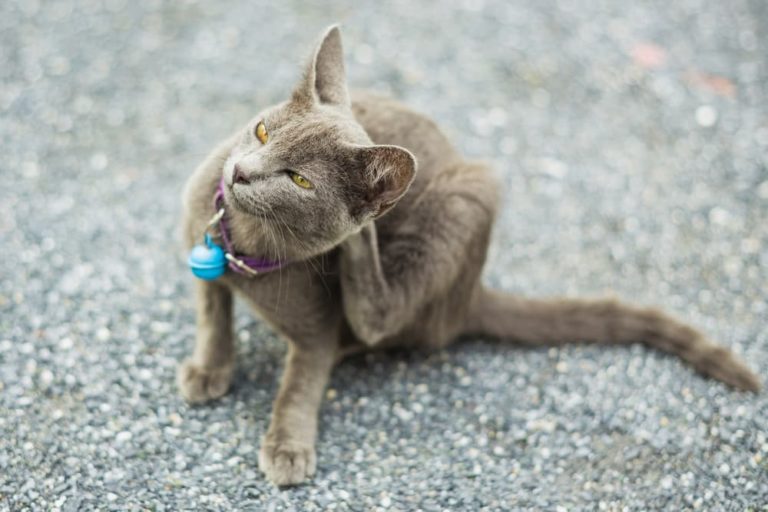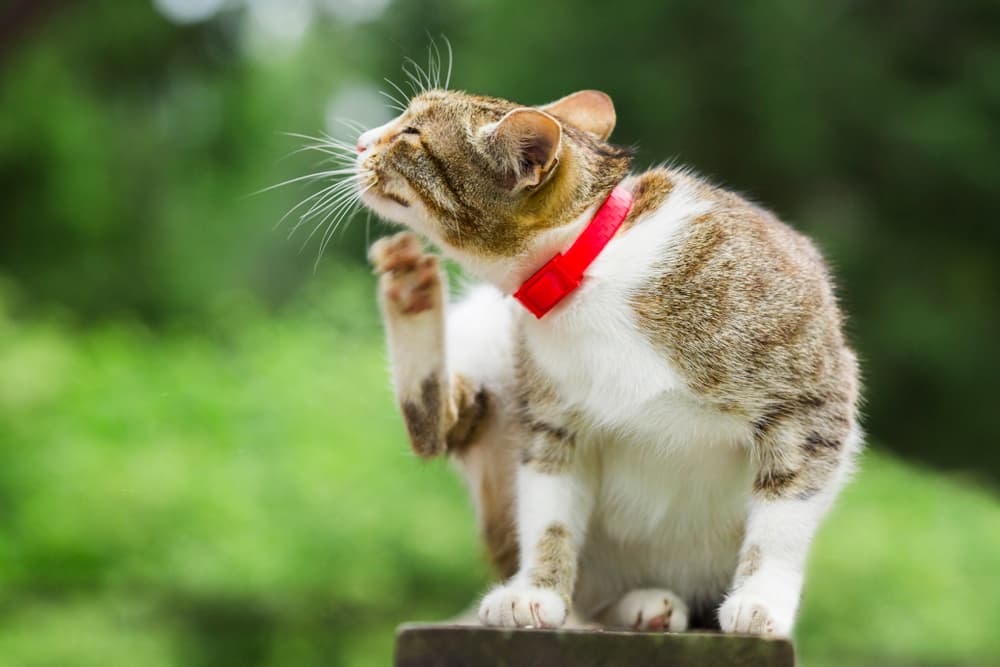Preventing Fleas on Cats: Methods, Tips, and Product Options

If the thought of fleas hopping between you and your pet makes your skin itch, you’re not alone. That, paired with the fact that fleas can transmit serious diseases to you and your pet, is why veterinarians recommend routine flea prevention for cats.
“Fleas are small insects that survive by feeding on animal or human blood,” explains Dr. Kathryn Duncan, DVM, Ph.D., DACVM, a parasitology field specialist at Merck Animal Health. “They’re found in many geographical locations and environments—even indoors—and can affect cats of all ages and breeds.”
To protect both pets and humans from these nasty critters, we’ve rounded up the most effective options for preventing fleas on cats.
Flea Prevention for Cats: Why It’s Important
Once fleas find a steady food source, like your cat, they tend to remain on that animal. However, their eggs will fall off into the environment, becoming scattered throughout your home. These eggs will eventually hatch and become larvae, and then they will grow into biting adults. Once fleas invade your home, it could take months to get rid of them.
“Fleas cause irritation and skin allergies, and can transmit other parasites such as tapeworms to your cat,” Dr. Duncan says. “In kittens, fleas can cause fatal anemia if present in large numbers.”
When not biting your cat—commonly around their neck, ears, and tail—fleas happily feast on humans. Duncan warns that fleas don’t just cause itchy welts; they can spread diseases to us, such as flea-borne typhus and cat scratch disease (CSD).
In order to prevent the risky and unpleasant effects of fleas, it’s essential to ensure that all of your pets receive veterinarian-recommended flea prevention on a regular basis.
How to Prevent Fleas on Cats: 5 Methods to Try

Fleas are a problem for many cats; just ask Dr. Patrik Holmboe, DVM, who says treating and discussing cat flea prevention is an everyday occurrence at his Amsterdam-based clinic. But there’s good news: flea infestations are typically preventable—when your cat is routinely treated with preventative flea medication, he says.
While there are many ideas when it comes to flea prevention for cats, Dr. Duncan says she only trusts Federal Drug Administration (FDA)- or Environmental Protection Agency (EPA)-approved products to be effective and safe.
In addition to giving prescription flea prevention for cats, the following steps can also help reduce the risk of fleas entering your home:
Limit travel. Anywhere other pets have been, like a boarding facility, is at risk of harboring fleas.
Keep a sanitary home. Rodents have their own fleas, but despite the name (rat fleas), they’ll happily hop onto you or your cat.
Limit outdoor exposure. Even if your cat doesn’t venture outdoors, fleas from the environment can latch onto shoes or clothing from other flea-infested homes.
Don’t share pet supplies. This is especially true for any brushes, pet clothing, or carriers from friends or the thrift store. If bringing home any secondhand supplies, transport them in a sealed plastic bag and immediately wash them once home.
Limit exposure to other pets. Since fleas can jump from pet to pet or humans—yes, dogs can give fleas to humans and cats—avoid spending time with any pets that aren’t treated with flea control medication.
Vacuuming your home and furniture continuously for about three weeks is a crucial step in eradicating an established flea infestation. However, the veterinarians we spoke to say deep cleaning, pesticides, and natural remedies will not stop fleas from hitching a ride on your pet. Treating your home is unlikely to be fruitful unless you take steps to prevent reinfestation.
Remember, these measures are not as beneficial as the year-round use of an effective flea prevention product. To truly prevent fleas, you’re going to need to work with your veterinarian to develop a flea prevention plan.
Flea Preventatives for Cats: Options to Consider
According to Drs. Holmboe and Duncan, preventative flea medication is the number one way to protect your cat, yourself, and your home from fleas.
“We are lucky there are options for effective and safe flea control in cats, and product recommendations vary based on individual preferences,” Dr. Duncan says. When in doubt about the best flea prevention for cats, consider these options, then talk to your veterinarian.
Topical Flea Treatment for Cats

FDA- and EPA-approved topical or spot-on flea treatments for cats are a safe and effective way to prevent fleas—if applied correctly, our experts stress. “This involves placing the product on the animals’ skin, not their fur,” Dr. Holmboe says. “Additionally, make sure the animal doesn’t lick it off or otherwise get the medication washed off within 24 hours of application.” Some products are absorbed through the skin and enter the bloodstream [1, 2], while many topical preventatives instead distribute across your cat’s skin and oil glands.
A compelling perk of topical flea medications for cats is that they may protect your pet against other parasites, such as heartworms, hookworms, ear mites, and ticks, in addition to killing and preventing fleas. Topical flea treatments for cats should be applied every one to three months, depending on the medication you choose. Read the product label or ask your veterinarian if you have questions about the dosing frequency for your cat’s flea prevention.
Oral Flea Treatment for Cats

Oral medication is Dr. Holmboe’s go-to method of flea prevention for cats, and it works very quickly. Medications with the active ingredient nitenpyram, for example, start killing fleas within 30 minutes of taking the pill [3], however this product only remains in the bloodstream for a short time and does not offer any long-last prevention. In contrast, lotilaner (Credelio) begins killing fleas in as little as 8 hours [4] and prevents reinfestation for one full month.

While oral medication allows you to avoid the need for skin application, you have to convince your cat to swallow a pill or eat a chewable tablet. Cats may readily accept the medication if it has an appealing smell and flavor. For example, Credelio CAT is a small, chewable tablet made with a vanilla and yeast scent and flavor to please even picky cats. Like topical flea treatments, FDA-approved oral flea treatments for cats are considered safe and effective. Depending on the product you choose, it should be administered every one to three months, according to the instructions on the label.
Flea Collars for Cats

According to Dr. Holmboe, the benefit of cat flea collars is that they are effective for six or more months. However, he says they’re not as effective as oral or spot-on flea treatments for cats [5] and can become a safety hazard if snagged. Many cat flea collars kill existing fleas and protect against fleas and ticks.
Natural Flea Treatment for Cats and Other Product Considerations

Other cat flea treatments include medicated flea shampoos, powders, and dips made especially for cats and kittens. These can be useful for treating an initial flea infestation, but they won’t protect your cat from future fleas, Dr. Holmboe says. Additionally, some products may be toxic for cats. Unlike other cat flea treatments, there are some flea shampoos that may be safe for kittens. However, always consult your veterinarian before putting anything in your kitten’s fur on their skin.
As for natural flea remedies for cats, Dr. Holmboe says they’re just not effective. Rather than reaching for potentially dangerous essential oils or other natural remedies, discuss the pros and cons of each medicated option carefully with your veterinarian. They can help you decide which flea preventative is best for your cat.
Cat Flea Preventatives: Safety Tips

According to the FDA, there have been limited reports of topical flea products with the active ingredient isoxazoline associated with neurologic adverse reactions, including muscle tremors, ataxia, and seizures [6]. However, Dr. Duncan says, “the benefits of flea prevention outweigh the potential, and rare, side effects.”
To ensure the safest and most effective application of flea medication, our experts offer a few tips:
Follow all product guidelines. If you have questions about how to apply or administer your cat’s flea medication, contact the manufacturer, or talk to your veterinarian.
Use the correct dose and never split doses between pets. Because products made for dogs can be toxic to cats, only apply or administer flea medication labeled for cats.
Don’t use expired medications. “It’s best to throw away expired products and purchase new as efficacy declines after expiration,” Dr. Duncan says.
Follow the recommended application intervals. Dosing intervals vary by medication, so always read the label before applying or administering the next dose. Because fleas can survive indoors during winter months, Dr. Duncan recommends treating pets with flea preventatives year-round.
Monitor your cat. “There are minor and rare side effects that may result from using flea and tick preventives, such as low appetite, lethargy, or vomiting,” Dr. Duncan says. “Pet owners should monitor their pet’s behaviors within the first few days of treatment and seek care from a veterinarian if side effects occur.”
What to Do if You Find a Flea on Your Cat
Look for signs of redness, crusting, or scabs on your cat’s skin if they’re scratching more than usual. When inspecting your cat’s skin, you may spot live fleas moving around in their fur and small black dots, which are flea dirt or flea waste material. Flea combs can also be used at home to routinely check your cat for fleas.
If you suspect your cat has fleas—or any other skin condition—call your veterinarian for care. They’ll likely recommend or prescribe medication to kill fleas and prevent their return.









